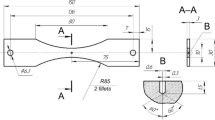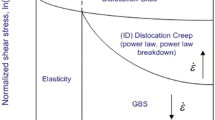Abstract
An existing extensive database on the isothermal and thermomechanical fatigue behaviour of high-temperature titanium alloy EVII 834 and dispersoid-strengthened aluminum alloy X8019 in SiC particle-reinforced as well as unreinv conditions was used to evaluate both the adaptability of fracture mechanics approaches to TMF and the resulting predictive capabilities of determining material life by crack propagation consideration. Selection of the correct microstructural concepts was emphasised and these concepts were, then adjusted by using data from independent experiments in order to avoid any sort of fitting. It is shown that the cyclic /-integral (δJeff concept) is suitable to predict the cyclic lifetime for conditions where the total crack propagation rate is approximately identical to pure fatigue crack growth velocity. In the case that crack propagation is strongly affected by creep, the creep-fatigue damage parameter δCF introduced by Riedel can be successfully applied. If environmental effects are very pronounced, the accelerating influence of corrosion on fatigue crack propagation can no longer implicitly be taken into account in the fatigue crack growth law. Instead, a linear combination of the crack growth rate contributions from plain fatigue (determined in vacuum) and from environmental attack is assumed and found to yield a satisfactory prediction, if the relevant corrosion process is taken into account.
Similar content being viewed by others
References
Angers L, Fine M E, Weertman J R 1987 Effect of plastic deformation on the coarsening of dispersoids in a rapidly solidified Al-Fe-Ce alloy.Metall. Trans. A18: 555–562
ASME 1994 ASME Boiler and Pressure Vessel Code: Section 3, Rules for construction of nuclear Power Plant Components, New York
Bernstein H L, Grant T S, McClung R C, Allen J M 1993 Prediction of thermal-mechanical fatigue life for gas turbine blades in electric power generation.Thermomechanical fatigue behaviour of materials (ed.) H Sehitoglu, ASTM STP 1186 (Philadelphia, PA: ASTM) pp 212–238
Chaboche J L, Lesne P M 1988 A non-linear continuous fatigue damage model.Fatigue Fracture Eng. Mater. Struct. 11: 1–17
Christ H -J, Mughrabi H, Kraft S, Petry F, Zauter R, Eckert K 1996 The use of plastic strain control in thermomechanical fatigue testing.Fatigue under thermal and mechanical loading — Mechanisms, mechanics and modelling (eds) J Bressers, L Rémy (Dordrecht: Kluwer Academic) pp 1–14
Dai J, Marchand N J, Hongoh M 1996 Thermal mechanical fatigue crack growth in titanium alloys: Experiments and modelling.Thermomechanical fatigue behaviour of materials: second volume (eds) M J Verrilli, M G Castelli, ASTM STP 1263 (West Conshohocken, PA: ASTM) pp 187–209
Danzer R 1988Lebensdauerprognose hochfester metallischer Werkstoffe im Bereich hoher Temperaturen (Berlin-Stuttgart: Gebrüder BorntrÄger)
Dowling N E 1977 Crack growth during low-cycle fatigue of smooth axial specimens.Cyclic stress-strain and plastic deformation (ed.) L F Impellizzeri, ASTM STP 637 (Philadelphia, PA: ASTM) pp 97–121
Ellison E G, Al-Zamily A 1994 Fracture and life prediction under thermal-mechanical strain cycling.Fatigue Fracture Eng. Mater. Struct. 17: 53–57
Halford G R, Lerch B A, Arya V K 2000 Thermal strain fatigue modeling of a matrix alloy for a metal matrix composite.Thermomechanical fatigue behaviour of materials: third volume (eds) H Sehitoglu, H J Maier, ASTM STP 1371 (West Conshohocken, PA: ASTM) pp 186–203
Halford G R, Manson S S 1976 Life prediction of thermal-mechanical fatigue using strain range partitioning.Thermal fatigue of materials and components (eds) D A Spera, D F Mowbray, ASTM STP 612 (Philadelphia, PA: ASTM) pp 239–254
Hardt S, Maier H J, Christ H -J 1999 High-temperature fatigue damage mechanisms in near-a titanium alloy IMI 834.Int. J. Fatigue 21: 779–789
Heitmann H H, Vehoff H, Neumann P 1984 Life prediction for random load fatigue based on the growth behaviour of microcracks.Advance in Fracture Research (ICF6) (eds) S R Valluri, D M R Tuplin, P R Rao, J F Knott, R Dublex (New Delhi: Pergamon) pp 3566–3606
Jordan E H, Meyers G J 1986 Fracture mechanics applied to nonisothermal fatigue crack growth.Eng. Fracture Mech. 23: 345–358
Jung A 2000Einfluss einer PartikelverstÄrkung auf das Hochtemperaturermüdungsverhalten einer dispersionsgehÄrteten Aluminiumlegierung. Doctorate thesis, UniversitÄt Siegen, Germany
Jung A, Maier H J, Christ H-J 1998a High-temperature fatigue behaviour and micro structure of a dispersoid-strengthened and SiC-reinforced aluminium alloy.Microstructure and mechanical properties of metallic high-temperature materials (eds) H Mughrabi, G Gottstein, H Mecking, H Riedel, J Tobolski (Weinheim, Germany: Wiley-VCH-Verlag) pp 34–49
Jung A, Maier H J, Christ H -J 1998b Low-cycle fatigue behaviour and lifetime prediction of a SiC-particulate reinforced aluminium alloy at elevated temperatures.Proc. 12th Conf. on Fracture (ECF12) (eds) M W Brown, E R de los Rios, K J Miller, pp 303–308
Jung A, Maier H J, Christ H -J 2000 Effect of SiC-reinforcement on thermomechanical fatigue of a dispersion-strengthened high-temperature aluminum alloy.Thermomechanical fatigue behaviour of materials: third volume (eds) H Sehitoglu, H J Maier, ASTM STP 1371 (West Conshohocken, PA: ASTM) pp 167–185
Kadioglu Y, Sehitoglu H 1996 Thermomechnical and isothermal fatigue behaviour of bar and coated superalloys.J. Eng. Mater. Technol. 118: 94–102
Lesterin S, Sarrazin-Baudoux C, Petit J 1996 Temperature-environment interactions on fatigue behaviour in Ti6246 alloy.Titanium ’95: Science and Technology (eds) P A Blenkinsop, W J Evans, H M Flower (London: Institute of Materials) pp 1211–1218
Liu Z, Welsch G 1988 Effects of oxygen and heat treatment on the mechanical properties of alpha and beta titanium alloys.Metall. Trans. A19: 527–542
Maier H J, Christ H -J 1997 Modeling of cyclic stress-strain behaviour and damage mechanisms under thermomechanical fatigue conditions.Int. J. Fatigue 19 (Suppl): 267–274
Maier H J, Teteruk R G, Christ H -J 2000 Modeling thermomechanical fatigue life of high-temperature titanium alloy IMI 834.Metall. Mater. Trans. A31: 431–444
Maier H J, Teteruk R, Christ H -J 2002 Modelling thermomechanical fatigue life.Materials at high temperatures (in print)
Miller M P, McDowell D L, Oehmke R L T, Antolovich S D 1993 A life prediction model for thermomechanical fatigue based on microcrack propagation.Thermomechanical fatigue behaviour of materials (ed.) H Sehitoglu, ASTM STP 1186 (Philadelphia, PA: ASTM) pp 35–49
Neal D F 1985 Optimization of creep and fatigue resistance in high temperature titanium alloys IMI 829 and IMI 834.Titanium science and technology (eds) G Lütjering, U Zwicker, W Bunk (Oberursel: Deutsche Gesellschaft für Metallkunde) pp 2419–2424
Neu R W, Sehitoglu H 1989 Thermo-mechanical fatigue, oxidation and creep: Part II — Life prediction.Metall. Trans. A20: 1769–1767
Nowack H, Kordisch T 1998 Kriech-Ermüdungsverhalten der Titanlegierung IMI 834 bei 600‡C.Materialwissensch. Werkstofftech. 29: 215–228
Okazaki M, Koizumi T 1983 Crack propagation during low cycle thermal-mechanical and isothermal fatigue at elevated temperatures.Metall. Trans. A14: 1641–1648
Pototzky P 1999Thermomechanischer Ermüdungsverhalten der Hochtemperaturtitanlegierung IMI 834. Doctorate thesis, UniversitÄt Siegen, Germany
Pototzky P, Maier H J, Christ H-J 1998 Thermomechanical fatigue behaviour of the high-temperature titanium alloy IMI 834.Metall. Mater. Trans. A29: 2995–3004
Pototzky P, Maier H J, Christ H -J 2000 Behaviour of the high-temperature titanium alloy imi 834 under thermomechanical and isothermal fatigue conditions.Thermomechanical fatigue behaviour of materials: third volume (eds) H Sehitoglu, H J Maier, ASTM STP 1371 (West Conshohocken, PA: ASTM) pp 18–35
Rémy L, Bernard H, Malpertu J L, Rezai-Aria F 1993 Fatigue life prediction under thermal-mechanical loading in a nickel-base superalloy.Thermomechanical fatigue behaviour of materials (eds) H Sehitoglu, ASTM STP 1186 (Philadelphia, PA: ASTM) pp 3–16
Reuchet J, Rémy L 1983 Fatigue oxidation interaction in a superalloy — Application to life prediction in high temperature low cycle fatigue.Metall. Trans. A14: 141–149
Riedel H 1987Fracture at high temperatures (eds) B Ilschner, N J Grant (Berlin: Springer)
Sarrazin-Baudoux C, Lesterin S, Petit J 1996 Atmospheric influence on fatigue crack propagation in TiAl6V alloy up to 300‡C.Titanium’95: Science and technology (eds) P A Blenkinsop, W J Evans, H M Flower (London: Institute of Materials) pp 1895–1902
Skelton R P 1983 Crack initiation and growth in simple metal components during thermal cycling.Fatigue at high temperature (eds) R P Skelton (London: Applied Science Publishers) pp 1–63
Teteruk R 2001Modellierung der Lebensdauer bei thermomechanischer Ermüdungsbeanspruchung unter Berücksichtigung der relevanten SchÄdigungsmechanismen. Doctorate thesis, UniversitÄt Siegen, Germany
Woodford D A, Mowbray D F 1974Effect of materials characteristics and test variables on thermal fatigue of cast superalloys.Mater. Sci. Eng. 16: 5–43
Zamrik S Y, Renauld M L 2000 Thermo-mechanical out-of-phase fatigue life of overlay coated IN-738LC gas turbine materials.Thermomechanical fatigue behaviour of materials: thirdvolume (eds) H Sehitoglu, H J Maier (West Conshohocken, PA: ASTM) pp 119–137
Author information
Authors and Affiliations
Rights and permissions
About this article
Cite this article
Christ, H.J., Jung, A., Maier, H.J. et al. Thermomechanical fatigue—damage mechanisms and mechanism-based life prediction methods. Sadhana 28, 147–165 (2003). https://doi.org/10.1007/BF02717131
Issue Date:
DOI: https://doi.org/10.1007/BF02717131




